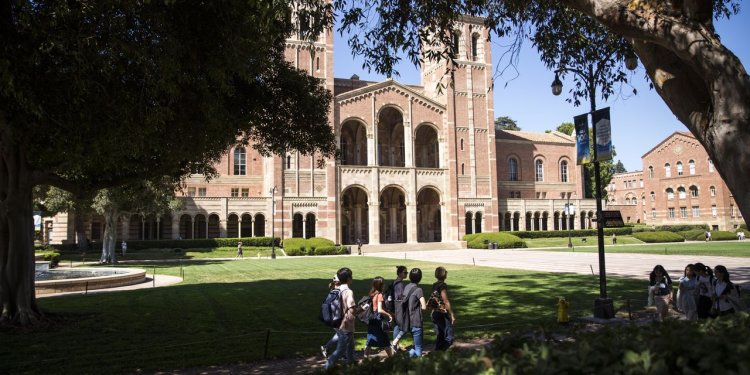Can Colleges Be Racially Diverse Without Affirmative Action? Experience Suggests No
By Melissa Korn June 29, 2023 10:41 am ET The Supreme Court says American colleges can no longer consider race in their admissions decisions. Instead, they can try to build racially diverse campuses through less-direct means. Experience suggests that is going to be a hard slog. Nine states, including California, Oklahoma, Michigan, Texas, Florida and New Hampshire, have already banned race-conscious admissions, mainly as a result of voter initiatives. Selective universities in some of those places say they are eager to reflect the demographics of the states they serve, in part because they believe a diverse population enriches students’ educational experiences. They have pursued

By
The Supreme Court says American colleges can no longer consider race in their admissions decisions. Instead, they can try to build racially diverse campuses through less-direct means. Experience suggests that is going to be a hard slog.
Nine states, including California, Oklahoma, Michigan, Texas, Florida and New Hampshire, have already banned race-conscious admissions, mainly as a result of voter initiatives. Selective universities in some of those places say they are eager to reflect the demographics of the states they serve, in part because they believe a diverse population enriches students’ educational experiences.
They have pursued a range of new approaches and doubled down on others to boost the numbers of Black, Hispanic and Native American students on campus, including expanding recruiting in minority neighborhoods and considering proxies for race, such as socioeconomic status—and yet consistently fell short of their goals.
At the Berkeley and Los Angeles campuses of the University of California, the share of Black and Hispanic students fell by about half immediately after a voter referendum in 1996. Despite a bevy of recruiting and admissions initiatives, the schools still aren’t enrolling Hispanic students in a way that reflects state demographics, data show.
“They went through the whole playbook and still are not where they were before,” said Zachary Bleemer, an assistant professor of economics at the Yale School of Management who studied the impact of changes to University of California admissions policies. “It’s clear that California or other states that have experienced affirmative action bans do not offer a silver bullet.”

Among the reasons why these efforts have fallen short: Colleges often look first to socioeconomic status as an alternative to race, given the significant overlap between racial minorities and low-income students. But it’s a flawed proxy. There are more low-income white households than there are low-income Black and Hispanic households combined.
Another approach guarantees admission to top graduates from every high school. That may yield more Black or Hispanic admissions only if the schools are dominated by such students. Diverse high schools don’t move the needle much.
Scarce resources complicate the effort. Some schools say they don’t have the financial-aid budgets to support a lot of low-income students. The most sought-after institutions are limited by campus size.

Students near the Chan Shun Auditorium on the University of California, Berkeley.
Photo: David Odisho/Bloomberg News
Some attempts to reverse-engineer particular racial diversity levels—for instance, strongly favoring first-generation college students who grew up speaking Spanish in one-parent households or setting different income thresholds for certain groups of students—may be legally fraught, said Gail Heriot, a law professor at the University of San Diego and a member of the U.S. Commission on Civil Rights.
“If a college or university selects those factors with race in mind, that is going to be just as illegal as doing it directly,” said Heriot, who in a 2021 legal brief to the Supreme Court argued that racial preferences in admissions don’t necessarily promote integration.
The University of California has navigated this race-neutral terrain for decades, after a 1996 ballot initiative called Proposition 209 barred the use of race in admissions decisions at public universities. In 2020, voters rejected an effort to reverse the policy.
Since Prop 209 passed, the university has spent hundreds of millions of dollars expanding the pipeline of prospective minority students. The system, which has 10 campuses across the state, nine with undergraduate programs, built partnerships with high schools and community-based organizations in low-income and more diverse neighborhoods. It stepped up recruiting at churches and nonprofits such as Black Girls Code. Once it received applications, it also paid attention to biographical details such as whether someone held a job throughout high school or the first in their family to attend college.
While the proportion of students who are Asian remained far higher than their share of new high-school graduates, Black and Hispanic enrollment at top UC schools has lagged behind. Hispanic students made up 53% of new high-school graduates in California in 2021, compared with 27% of first-year students at the University of California, Berkeley and 36% across the UC system.
Black students, meanwhile, were 5% of the 2021 high school graduating class, 2% of first-year students at Berkeley and 2.4% of first-year students systemwide.
“We have tried multiple avenues to promote these race-neutral means of recruitment and outreach, but there’s only so much that the UC can do,” said Han Mi Yoon-Wu, executive director of undergraduate admissions at the University of California.

The University of Michigan Law Quad in Ann Arbor, Mich.
Photo: Erin Kirkland for the Wall Street Journal
Yoon-Wu blamed inadequate funding for public schools that enroll a high percentage of minority students. “It really has to start in the K-12 system, having equity amongst the schools and resources for the students,” she said.
Selective California schools have been especially hard to crack. In 2001, when the university began guaranteeing admission for in-state students in the top 4% of their high-school class, the Berkeley and Los Angeles campuses chose not to participate.
As the most popular target campuses in the system, they couldn’t have accommodated the throngs of top-4% students who likely would have applied, said University of California spokesman Ryan King.
In 2012, UC expanded the program, guaranteeing the top 9% of graduates slot somewhere in the system, though not to any specific school. Other campuses joined Berkeley and UCLA on the sidelines, and now even superstars from some high schools are passed over by all but the Merced location. That rural campus is significantly smaller than other UC schools and draws heavily from its immediate surroundings in the San Joaquin Valley. More than half of undergraduate students at Merced are Hispanic, and another 24% are Asian.
Florida eliminated race-based affirmative action after a 1999 executive order by then-Governor Jeb Bush, a Republican. The state guarantees admission to its public university system—though not to specific campuses—to the top 20% of public high-school graduates there. Such plans have proven only moderately successful in boosting minority enrollment.
At the flagship University of Florida, the share of Black students rose for some years after the policy was enacted, but declined over the past decade to 5.5% in 2022. That’s below where it was before the change and far below the share of Florida high-school graduates who are Black. Enrollment by Hispanic students has roughly doubled, to about 21%, but they are also still underrepresented compared with the state’s high school population.
Florida’s Department of Education and the University of Florida didn’t respond to a request for comment about the impact of the top-20% program.

Students on the University of Texas campus in Austin, where capacity constraints limit admissions of top high school applicants.
Photo: Bill McCullough for The Wall Street Journal
Texas guaranteed admission beginning in 1998 to any state university for students in the top 10% of their graduating classes, though lawmakers subsequently relaxed that requirement for the most coveted destination, the University of Texas at Austin. Because of limited capacity, UT Austin now offers automatic admission to just the top 6%.
The Texas policy slightly expanded the roster of high schools represented at UT Austin and the main Texas A&M University campus in College Station, according to an 18-year review of admissions and enrollment data by professors from Texas A&M and the University of North Carolina at Chapel Hill.
The researchers determined any increase in racial diversity at the universities was more likely tied to state demographics than to the policy, as schools that previously didn’t send students to the flagships still didn’t do so en masse.
Race-based and income-based affirmative action aren’t mutually exclusive, and opponents of using race in admissions say schools can diversify instead by giving extra consideration to low-income students.
Socioeconomic status turns out to be a weak proxy for race. In the U.S. the median income for non-Hispanic white households—$78,000—was about one-third higher than it was for Hispanic households in 2021, and the gap was even larger with Black families. Yet there were more than three times as many white households earning under $50,000 in 2021 as there were Black or Hispanic households with similar earnings, census data show.
Colleges trying to increase diversity by considering an applicant’s zip code or how many students in a high school get free or reduced-price lunch may end up with a more socioeconomically diverse class, but the efforts won’t necessarily yield much in terms of racial diversity.
Some schools say they can’t afford to double down on outreach to low-income students. Selective colleges often already consider an applicant’s family financial situation, noting whether someone worked part time through high school or attended an under-resourced school.
But awarding spots to low-income students generally only results in enrollment if the offers come with significant scholarship support. By focusing on race, schools previously could still pluck middle-class and wealthy minority students, balancing their budgets while pursuing a path to diversity.
“Most institutions, even if they wanted to, could not admit every qualified, low-income student that was in their pool. They don’t have the resources,” said Angel Pérez, chief executive of the National Association for College Admission Counseling, which represents admissions officers and high school counselors.

Harvard University in Cambridge, Mass., was a defendant in a Supreme Court case on affirmative action.
Photo: Kayana Szymczak for The Wall Street Journal
The University of Michigan says it has struggled to maintain adequate diversity since voters banned preferential treatment on the basis of race, sex and other factors in 2006, despite a number of initiatives targeting new groups of prospective students and increasing financial aid to help low-income students in particular.
The school has pursued many of the same outreach efforts as California, including stationing admissions officers in new areas and starting conversations with prospective students early in their school careers.
It launched a program that provides students in lower-income parts of the state, beginning in seventh grade, with academic tutoring and college-prep courses, awarding full-tuition scholarships to those who complete the curriculum and are admitted. It introduced a scholarship program covering tuition and fees for in-state students with family incomes under $65,000. It also stopped bringing in as many students through its early-admission program, so as not to shut out low-income and underrepresented minority students who are less likely to apply in early rounds.
Administrators said those efforts didn’t substantially move the needle, in part because the number of minority applicants with top academic qualifications remained small.
Black undergraduate enrollment there fell from 7% in fall 2006, the last year before its ban took effect, to 4.1% in 2022. While overall enrollment has grown by about 7,000, the number of Black students fell by about 375. Enrollment by Native American students dropped by close to 300, to .1% of undergraduates—40 students in all—from 1%.
More substantial diversity on a campus exposes students to new ideas and can help dispel stereotypes, proponents say.
Michigan administrators said in a 2022 Supreme Court filing that the low numbers of minority students leave some feeling isolated and burdened with being the sole representatives of their race in particular classes. That in turn can discourage others from considering the school, they said, leading to further underrepresentation.
Write to Melissa Korn at [email protected]
What's Your Reaction?

















